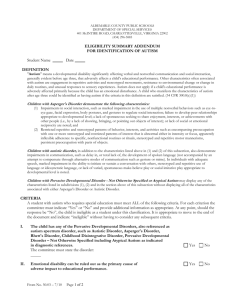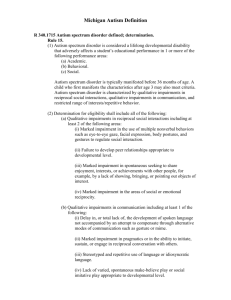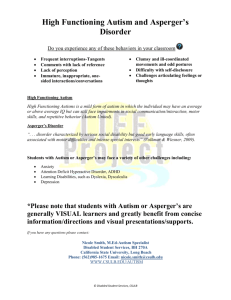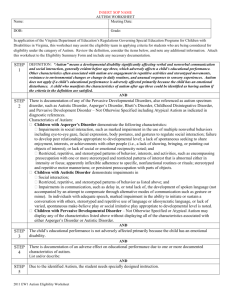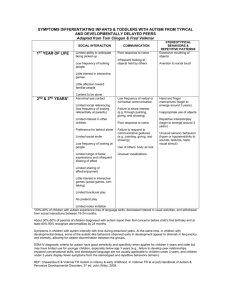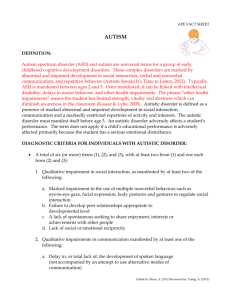Autism
advertisement
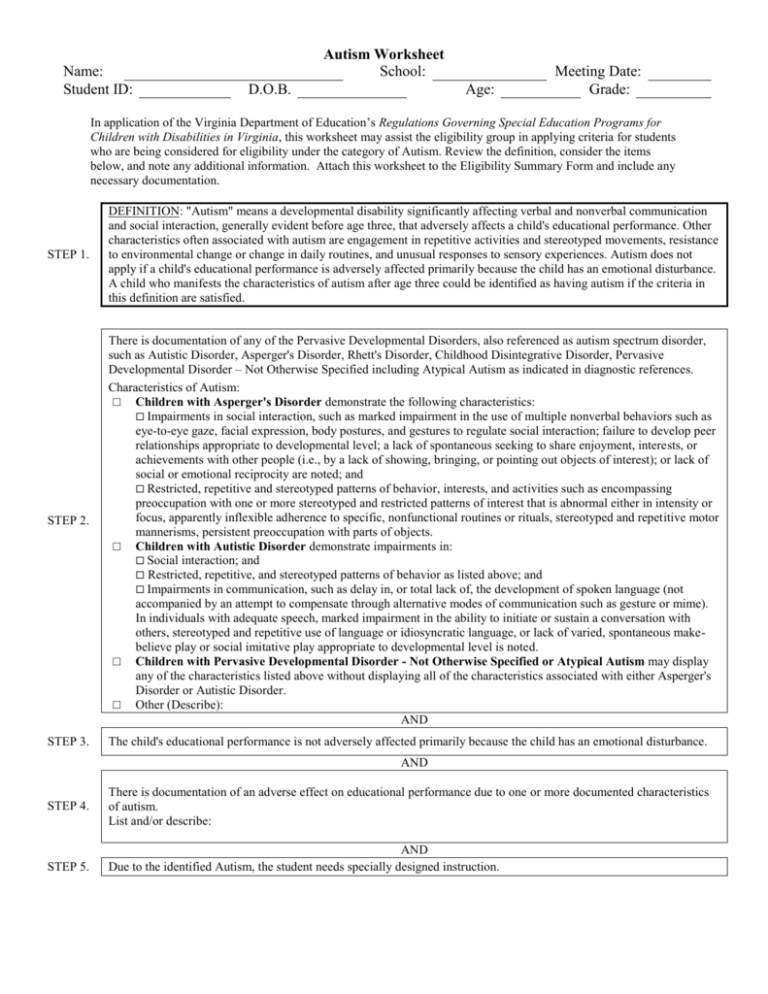
Name: Student ID: Autism Worksheet School: D.O.B. Age: Meeting Date: Grade: In application of the Virginia Department of Education’s Regulations Governing Special Education Programs for Children with Disabilities in Virginia, this worksheet may assist the eligibility group in applying criteria for students who are being considered for eligibility under the category of Autism. Review the definition, consider the items below, and note any additional information. Attach this worksheet to the Eligibility Summary Form and include any necessary documentation. STEP 1. STEP 2. STEP 3. DEFINITION: "Autism" means a developmental disability significantly affecting verbal and nonverbal communication and social interaction, generally evident before age three, that adversely affects a child's educational performance. Other characteristics often associated with autism are engagement in repetitive activities and stereotyped movements, resistance to environmental change or change in daily routines, and unusual responses to sensory experiences. Autism does not apply if a child's educational performance is adversely affected primarily because the child has an emotional disturbance. A child who manifests the characteristics of autism after age three could be identified as having autism if the criteria in this definition are satisfied. There is documentation of any of the Pervasive Developmental Disorders, also referenced as autism spectrum disorder, such as Autistic Disorder, Asperger's Disorder, Rhett's Disorder, Childhood Disintegrative Disorder, Pervasive Developmental Disorder – Not Otherwise Specified including Atypical Autism as indicated in diagnostic references. Characteristics of Autism: □ Children with Asperger's Disorder demonstrate the following characteristics: Impairments in social interaction, such as marked impairment in the use of multiple nonverbal behaviors such as eye-to-eye gaze, facial expression, body postures, and gestures to regulate social interaction; failure to develop peer relationships appropriate to developmental level; a lack of spontaneous seeking to share enjoyment, interests, or achievements with other people (i.e., by a lack of showing, bringing, or pointing out objects of interest); or lack of social or emotional reciprocity are noted; and Restricted, repetitive and stereotyped patterns of behavior, interests, and activities such as encompassing preoccupation with one or more stereotyped and restricted patterns of interest that is abnormal either in intensity or focus, apparently inflexible adherence to specific, nonfunctional routines or rituals, stereotyped and repetitive motor mannerisms, persistent preoccupation with parts of objects. □ Children with Autistic Disorder demonstrate impairments in: Social interaction; and Restricted, repetitive, and stereotyped patterns of behavior as listed above; and Impairments in communication, such as delay in, or total lack of, the development of spoken language (not accompanied by an attempt to compensate through alternative modes of communication such as gesture or mime). In individuals with adequate speech, marked impairment in the ability to initiate or sustain a conversation with others, stereotyped and repetitive use of language or idiosyncratic language, or lack of varied, spontaneous makebelieve play or social imitative play appropriate to developmental level is noted. □ Children with Pervasive Developmental Disorder - Not Otherwise Specified or Atypical Autism may display any of the characteristics listed above without displaying all of the characteristics associated with either Asperger's Disorder or Autistic Disorder. □ Other (Describe): AND The child's educational performance is not adversely affected primarily because the child has an emotional disturbance. AND STEP 4. STEP 5. There is documentation of an adverse effect on educational performance due to one or more documented characteristics of autism. List and/or describe: AND Due to the identified Autism, the student needs specially designed instruction.

